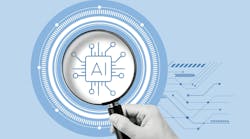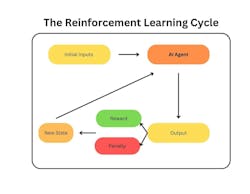Artificial intelligence (AI) has become increasingly popularized within dental innovation, revolutionizing both clinical and administrative processes. As the technology continues to advance, especially with generative AI models like ChatGPT, autonomous AI agents are poised to become increasingly significant. By making administrative tasks more efficient and enabling more precise and accurate reasoning models, AI-driven autonomous agents can bring forth a new era of personalized, data-driven decision-making within dental medicine.
What are AI agents?
An AI agent is an autonomous agent that receives inputs from its surroundings and autonomously executes an output using previous training data and fine-tuning, all without human intervention. Developed to perform specific tasks or achieve predefined goals autonomously, with tasks requiring multiple steps, agents make decisions that leverage training data and learn from previous decisions.1 Within dentistry, agents can manage tasks such as administrative scheduling and insurance claim assistance to clinical follow-ups and patient communication.
What is reinforcement learning?
Traditional generative models are trained with supervised learning, which relies on a large dataset of labeled inputs and outputs that allow the model to learn from these examples. Using an input such as patient conditions, for example, the model can be trained to predict an output, like a maxillofacial classification or the best treatment plan for the patient given success or failures from previous patient data. Repeated examples allow the model to adjust internal parameters to improve predictions. Dentistry, however, has many clinical processes that are more complex and require numerous internal steps, processes too complex to be captured by a traditional supervised-learning training method.
Reinforcement learning (RL) is a new form of model training that can learn to make numerous decisions to reach the target outcome; RL trains beyond the matching of a single input to a single output and instead trains a model to reason through numerous steps (figure 1). It allows the model to adjust outcomes at each step to best reach the result, receiving feedback and adjusting its strategy to reach the most accurate and precise outcome. This multistep, sequential training method can be used to train more complex, dental-specific use cases where advanced reasoning can result in enhanced diagnostics, planning, and more efficient and personalized patient care.
When RL is integrated into autonomous agents, AI agents can make adaptive, sequential decisions that use input and midstep feedback to best execute a task; if properly trained and implemented, these agents can radically improve the efficiency and workflow in the manner we practice dentistry. Imagine a dental practice wants to utilize AI, for example, to send out the insurance claims of patients who receive treatment. Input information must be fed to the model: policy details, treatment records, and relevant billing codes. An agent must then use this information to accurately draft an email that details the claim. The agent must pull relevant information such as radiographs and constant information from the patient and insurance company file to best execute the task. If properly trained with RL, the model may even be used to organize accepted or rejected claims, and then draft appeal emails back to the insurance company if necessary. Using RL, AI agents can be trained to learn logical workflows that can optimize communication with insurance providers.
Applications in dentistry
AI agents can use RL to streamline multiple areas of dental care.
Administrative use cases:
Appointment and workflow management: Dynamic scheduling that prioritizes urgent cases, optimizes staff availability, and adapts to real-time changes
Insurance processes: Automated claims submissions and appeals that reduce errors and speed up reimbursement
Supply and inventory control: Monitoring of dental materials based on usage patterns and automatic ordering to optimize stock levels
Patient communication: Tailored reminders, pre- and post-op instructions and personalized back-and-forth interactions with patients
Clinical use cases:
Preventive screenings: Early detection of issues such as caries or periodontal disease by analyzing imaging data step by step, improving accuracy over time
Treatment planning: Personalized recommendations that account for medical history, patient preferences, and insurance constraints
Patient education: Consistent, clear explanations of procedures, postcare instructions, and follow-up reminders that enhance patient engagement
External referrals: Assessing complex cases and determining when patients need referrals to specialist services, coordinating and tracking the referral process
While this technology has great potential within dental medicine, successfully deploying AI agents in practice poses risks that must be well understood and carefully considered. Data privacy is a large concern whenever patient data is used to model testing and training, as HIPAA compliance must be ensured. The models are also only as robust as the data used to train them, so ensuring a diverse, varied patient population in the training dataset is necessary for equitable, accurate clinical decision-making. Further, as AI’s role continues to expand into clinical care, it is crucial that the dentist has the ultimate responsibility for patient care. All AI-driven decisions must be monitored and approved by a licensed clinician.
By leveraging advanced AI capabilities with RL and AI agents under the expert oversight of dental professionals, we can ensure a future within dentistry that is not only increasingly efficient and data-driven, but that also remains firmly grounded in patient-centered values and care.
Editor's note: This article appeared in the April 2025 print edition of Dental Economics magazine. Dentists in North America are eligible for a complimentary print subscription. Sign up here.
Reference
- Uspenskyl S. Agents in artificial intelligence: what are they and how they are used. Springs. Accessed January 25, 2025. https://springsapps.com/knowledge/agents-in-artificial-intelligence-
what-are-they-and-how-they-are-used









